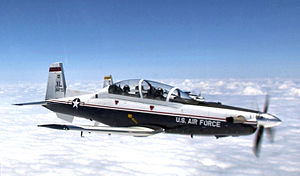Laughlin Air Force Base
| Laughlin Air Force Base | |
|---|---|
| Part of Air Education and Training Command (AETC) | |
| Located in Del Rio, Texas | |

T-6A Texan II, 84th Flying Training Squadron, Laughlin AFB
|
|
| Site information | |
| Controlled by |
|
| Site history | |
| Built | 1943 |
| In use | 1943-Present |
| Garrison information | |
| Garrison |
|
| Airfield information | |||||||||||||||||||
|---|---|---|---|---|---|---|---|---|---|---|---|---|---|---|---|---|---|---|---|
| Summary | |||||||||||||||||||
| Elevation AMSL | 1,082 ft / 329.8 m | ||||||||||||||||||
| Coordinates | 29°21′34″N 100°46′41″W / 29.35944°N 100.77806°WCoordinates: 29°21′34″N 100°46′41″W / 29.35944°N 100.77806°W | ||||||||||||||||||
| Website | www.laughlin.af.mil | ||||||||||||||||||
| Map | |||||||||||||||||||
| Location of Laughlin Air Force Base | |||||||||||||||||||
| Runways | |||||||||||||||||||
|
|||||||||||||||||||
Laughlin Air Force Base (IATA: DLF, ICAO: KDLF, FAA LID: DLF) is a facility of the United States Air Force located in Del Rio, Texas. As a census-designated place, it had a population of 1,648 at the 2015 census.
Laughlin AFB, the largest pilot training base in the US Air Force, is home to the 47th Flying Training Wing of the Air Education and Training Command. On weekdays, the airfield sees more takeoffs and landings than any other airport in the country.
Laughlin AFB was originally named Laughlin Army Air Field on March 3, 1943, after Jack T. Laughlin, a B-17E Flying Fortress pilot. He was trained as a pilot and was actually co-pilot of B-17E, Tail number 41-2476. The day of his first bombing mission, he was bumped by the Group Commander Major Stanley K. Robinson (Robinson was co-pilot next to Capt Walter W. Sparks pilot). Major Robinson brought along his own combat experienced navigator, Lt Richard Cease. Laughlin had no assigned position on the plane for the mission. He became Del Rio's first World War II casualty when the plane he was flying in (most likely as a waist gunner for the mission) was lost at sea, having succumbed to damage received over the Makassar Strait on 29 (or 28) January 1942. The damage occurred during two bombing runs against Japanese warships and transports in the Makassar Strait off the coast of Balikpapan, Borneo. The field became simply Laughlin Field on November 11, 1943 and later an Army Air Force Auxiliary Field. During World War II, Laughlin's primary mission was the training of B-26 pilots and aircrews. It was closed in October 1945.
Laughlin Air Force Base reopened on May 1, 1952. In October 1952, ATC transferred the base to Crew Training Air Force (CREWTAF) and activated the 3645th Flying Training Wing (Fighter), as a combat crew replacement training facility for pilots headed for Korea. Training provided new pilots with basic bombing and gunnery combat skills in the F-80 Shooting Star, F-84 Thunderjet, and T-33 jet aircraft, but within a short time crews used only the T-33. In Sept. 1955, Laughlin came under the control of the Flying Training Air Force and switched missions with Williams Air Force Base, Arizona. Laughlin undertook single-engine pilot training, still using the T-33.
...
Wikipedia

